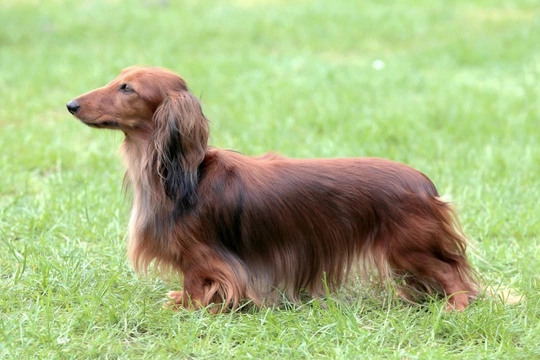
Dachshund or miniature Dachshund – which breed is right for you?
Dachshunds are very distinctive-looking small dogs with long bodies and short legs, and they’re also very popular as a whole in the UK. A Standard Dachshundis pretty small, but the miniature Dachshund is even smaller – and if you’ve decided that this is the type of dog you wish to own, one of the first things to decide is which variant is the best fit for you, and what you want from your prospective future dog.
Both the Dachshund and the miniature Dachshund do of course have a lot in common – but there are also several key differences between them as well as their size that you should factor in when making your decision.
In this article, we will look at the similarities and differences between the two breeds, and look at the pros and cons of both variants to help you to make a decision. Read on to learn more.
Are the Dachshund and miniature Dachshund the same breed?
Whilst the Dachshund and miniature Dachshund are of course close relatives, they are classed separately for breed shows, and the breed standard for each variant is slightly different. Both dogs are registered within the Kennel Club’s hound grouping, reflecting their common origins and historical working roles.
The difference in size
Standard Dachshunds stand between 20-27cm tall at the withers, and weigh between 9-12kg for both males and females. Miniature Dachshunds stand between 13-18cm tall at the withers, and weigh from 3.6-5kg for both males and females.
Whilst the standard dachshund is still a small dog by anyone’s standards, they are quite a lot larger than their miniature cousins – potentially weighing more than twice as much and being quite a bit taller.
History
As mentioned, the Dachshund and miniature Dachshund share a lot of the same history, dating right back to the breed’s known origins in 15th century Germany. Dogs of the type that we now call Dachshunds and miniature Dachshunds have also been seen in ancient artwork from both Egypt and Mexico.
The standard Dachshund is the original ancestor of the breed, and today’s miniature Dachshund is the result of selective breeding between small standard Dachshunds to continually reduce the size of the dogs in subsequent generations, resulting in the miniature Dachshund that we know today.
Dachshund variants
The two size categories of Dachshunds aren’t the only variants across the breeds – Dachshunds of both sizes can have quite variable coat types that all fall within the breed standard.
There a total of six recognised variants across the Dachshund dog type as a whole:
- Shorthaired Dachshund.
- Longhaired Dachshund.
- Wirehaired Dachshund.
- Shorthaired miniature Dachshund.
- Longhaired miniature Dachshund.
- Wirehaired miniature Dachshund.
All of the different size and coat type variants of Dachshunds can be seen in a wide range of different colours across both standard and miniature versions, which means that there is a lot of choice out there in terms of the appearance of the ultimate dog you choose.
Health and longevity
The average lifespan of the standard Dachshund is 12-13 years, while for miniature Dachshunds the average is rather higher, falling within the 14-17 year range.
As a general rule, smaller dogs tend to be longer lived than their larger cousins, and the conformation of the Dachshund dog type also goes some way towards explaining the small but significant variance across the two types.
The short legs and long body of the Dachshund makes them rather prone to spinal problems and issues with their backs, particularly as they get older – this can lead to problems including Dachshund paralysis in both the standard and miniature variants.
The longer the dog’s body in relation to the shortness of their legs – and their weight overall – contributes to and exacerbates spinal problems in dogs of this type, and the smaller miniature Dachshund has a better ratio between back length and leg length on average. This helps to contribute to their slightly higher average lifespans.
Both breeds have increased risk factors for progressive retinal atrophy, a painless but irreversible progressive blindness that can develop in affected dogs as they get older – and the miniature Dachshund also has higher risk factors for Lafora disease, a type of late-onset epilepsy.
Across both variants, pre-breeding health screening for progressive retinal atrophy is strongly advised, and in the miniature Dachshund, testing for the markers of Lafora disease is advisable too.
Prices
Dachshunds can be quite costly to buy, particularly if you are looking for a good quality pedigree dog that has undergone all of the appropriate health testing protocols prior to their parents’ mating match.
According to our own Pets4Homes average prices for the past 12 months, the average cost of registered pedigree standard Dachshund puppies sold in the UK as of 2018 is £1,277, and for non-registered dogs, £872.
The miniature Dachshund is slightly more expensive again, with registered pedigrees commanding figures in the region of £1,447, and non-registered puppies averaging £1,099.
This reflects both the higher demand for smaller dogs and to some extent, the health and longevity of the two respective variants.
Whatever Dachshund variant you ultimately choose to buy, always do your homework and research the breed in full before committing to a purchase, and assess breeders offering Dachshund puppies for sale carefully to ensure that you make the right choice.
Always ask about the breeder’s health testing protocols (and ask to see evidence of it) and the general background of both dam and sire, and always view the litter at home with their dam (and sire if possible) present.



